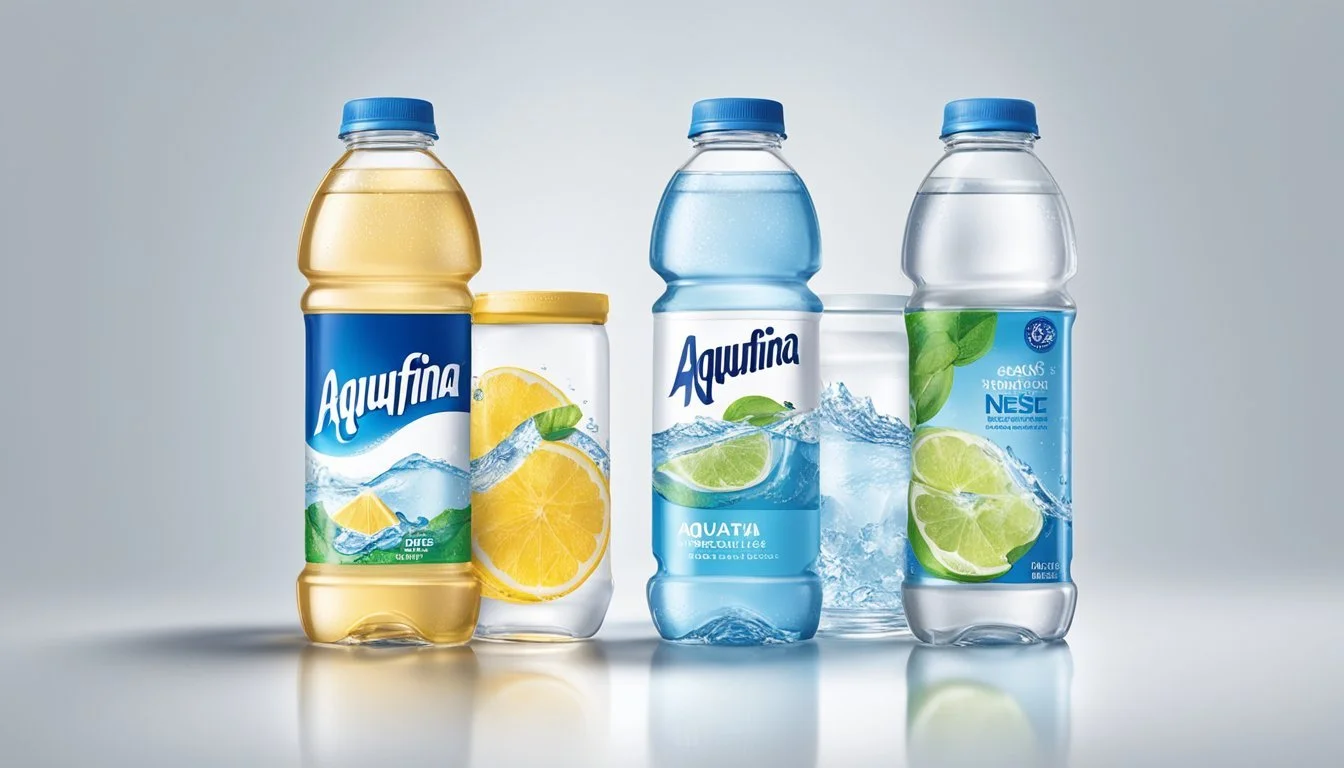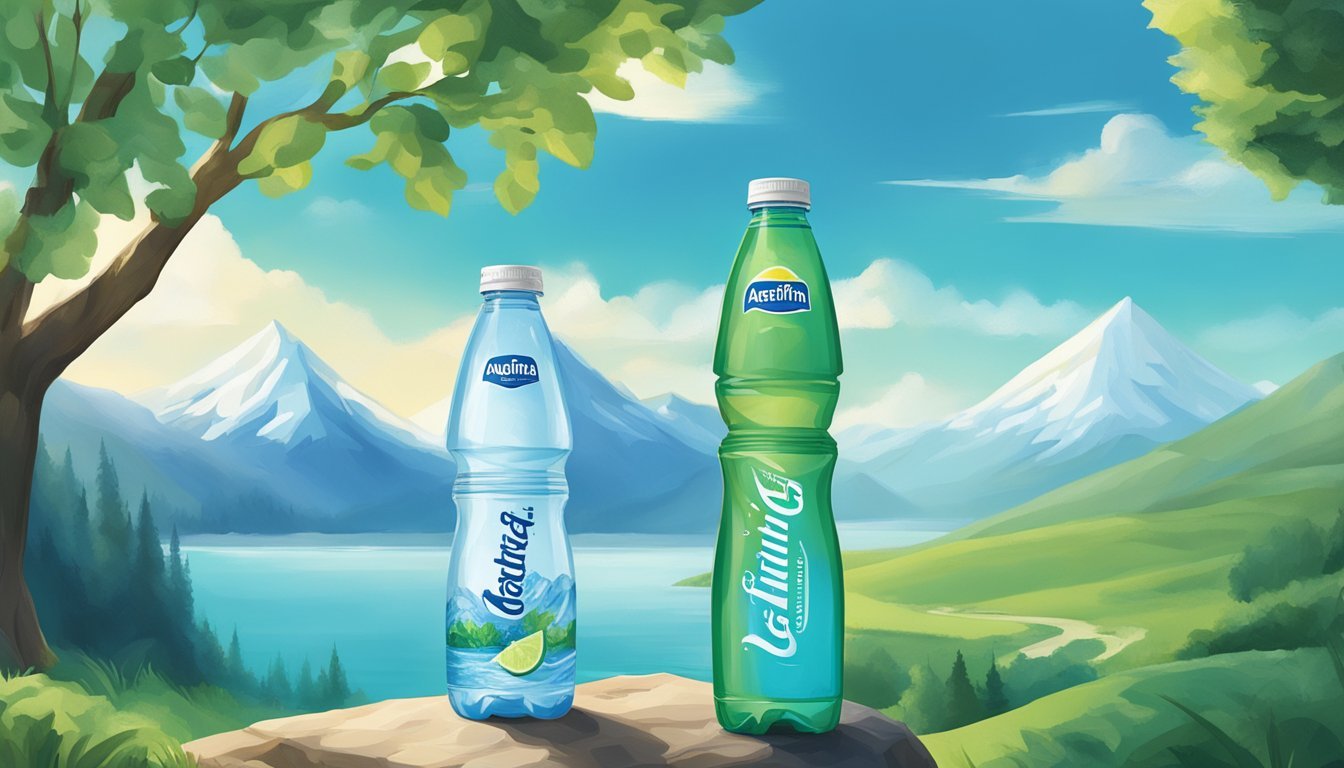Aquafina vs. Nestlé Pure Life
Comparing Quality and Taste
In the realm of bottled water, Aquafina and Nestlé Pure Life stand out as two of the most recognizable brands, each with its own unique selling points. Consumers often debate over the quality of these brands, gauging factors such as taste, purity levels, and the sources from which the water is drawn. With an increasing focus on health and wellness, the choice of bottled water can hinge on these variables, and some reports suggest that aspects like pH levels can influence consumer preferences, with neutral pH being perceived as beneficial.
Nestlé Pure Life is reported to have a more neutral pH level, which may align with the preferences of consumers seeking water that does not significantly affect the body's acid-base balance. On the other hand, Aquafina, which is purified through a rigorous purification process, has been reported to show up as acidic in some pH tests. This measurement indicates the presence of fewer minerals and a potential for a different interaction within the body.
The process through which each brand filters and purifies its water also contributes to the overall quality. While Aquafina employs a purification system known as HydRO-7, which includes multiple steps to ensure the cleanliness of the water, Nestlé Pure Life emphasizes not only purification but also the fortification of its product with a balanced mix of minerals for taste. Consumers weigh these factors alongside environmental considerations and the reputation of each brand, making the choice between Aquafina and Nestlé Pure Life a topic of personal preference guided by individual priorities.
Overview of Bottled Water Brands
Choosing between bottled water brands often comes down to personal preference, water source, and purification process. This section dives into the specifics of two well-known brands—Aquafina and Nestlé Pure Life—and provides insights into their market competition and consumer perception.
Aquafina
Aquafina is a brand of purified bottled water that is produced by PepsiCo. It undergoes a rigorous purification process that involves reverse osmosis and other filtration methods. Aquafina markets itself on purity and being free from added minerals or substances.
Nestlé Pure Life
Nestlé Pure Life originates from Nestlé, which owns various small water brands ranging from Poland Spring to Perrier. Pure Life is a type of purified water, distilled from municipal sources or well water, and may include a blend of minerals for taste.
Comparing Competitors
In the bottled water market, other notable players include:
Dasani: A Coca-Cola brand, similar to Aquafina in terms of purification process.
Evian: Known for its naturally occurring electrolytes, sourced from the French Alps.
Fiji: Sourced from an aquifer in Fiji, it maintains a distinct taste profile due to the volcanic rock it filters through.
Smartwater: Vapor-distilled water with electrolytes added for taste.
Each competitor differentiates itself through source, taste, or purification process, competing for various niches of consumer preference.
Consumer Perception
Consumer perception of bottled water brands can be influenced by many factors including taste, quality, and brand reputation. Brands like Voss and Icelandic Glacial have captured consumers' attention through premium packaging and marketing endorsements by celebrities. Contrastingly, brands like La Croix and San Pellegrino offer carbonated water options, highlighting consumer preference for variety. Although corporate giants like Evian, Fiji, and Perrier have been associated with status and luxury, brands like Aquafina and Nestlé Pure Life are typically perceived as everyday, accessible options.
Health and Hydration
When selecting bottled water, consumers often consider health benefits and hydration quality. The content of electrolytes and pH levels are two significant factors in this regard.
Hydration Benefits
Hydration is crucial for maintaining bodily functions, and consuming adequate water is essential for health. Aquafina and Nestlé Pure Life are both products designed to meet hydration needs. However, the source and treatment of the water can influence its ability to hydrate effectively. Both brands offer clean, purified water, but the hydration benefits remain similar as long as the consumer's intake meets their daily water requirements.
Electrolytes and pH Levels
Electrolytes are minerals in the body that have an electric charge. They are vital for hydration as they help balance the amount of water in the body. In terms of electrolyte content, Nestlé Pure Life indicates the addition of minerals for taste which may affect its electrolytic balance.
The pH levels across bottled waters can vary. A pH value of 7 is neutral, with values above 7 being alkaline (or basic) and below 7 being acidic. Alkaline water sometimes contains minerals and has a higher pH. Some research suggests that alkaline water can help neutralize acids in the body and improve hydration:
Aquafina: This brand undergoes a purification process that leads to a more acidic pH level.
Nestlé Pure Life: It tends to have a neutral pH level, which is closer to the body's natural pH balance.
Both Aquafina and Nestlé Pure Life offer hydration, but the latter might provide a more favorable electrolyte balance and pH level for those looking for a water with a neutral pH, potentially supporting better overall hydration.
Source and Purity of Water
In the comparison between Aquafina and Nestlé Pure Life, a discerning consumer takes into account the origin of the water and the effectiveness of the purification processes to ensure safety and quality.
Natural Sources
Aquafina does not typically highlight natural springs as its source; instead, it opts for public water supplies, also known as municipal sources. Nestlé Pure Life, while also using municipal sources, may incorporate natural sources into its product lineup, which could range from deep groundwater to protected wells.
Municipal Sources and Purification
Both brands initiate with municipal water sources. Aquafina employs a rigorous purification process that includes reverse osmosis and carbon filtration to remove most contaminants. In contrast, Nestlé Pure Life often adds minerals back to the water, such as potassium chloride, for taste after its own multi-step filtration process.
Contaminants and Filtration
To achieve purity, contaminant removal is essential. Aquafina claims to exceed federal purity standards, suggesting a near absence of common contaminants. Nestlé Pure Life takes a different approach; their filtration is aimed at reaching a balance that retains some mineral content while ensuring the removal of harmful substances through layers of permeable materials.
BPA and Bottle Safety
Bottle safety is paramount for health-conscious individuals. Aquafina and Nestlé Pure Life use bottles that are typically BPA-free to prevent chemical leaching. This ensures the water maintains its purity from source to consumption, adhering to consumer expectations of safety.
Environmental Impact and Sustainability
The bottled water industry faces scrutiny for its impact on ecosystems and the significant environmental footprint linked to production and consumption choices. Understanding these aspects is crucial in evaluating the sustainability of Aquafina and Nestlé Pure Life.
Ecosystems and Bottled Water Production
Research indicates that the production of bottled water has a substantially higher impact on ecosystems compared to tap water. For instance, bottling companies require a large amount of water extraction, which can alter local water tables and harm surrounding environments. Nestlé Pure Life has faced controversy for sourcing water from springs, which has raised concerns over the potential draining of natural resources that support local ecosystems. Aquafina, primarily sourced from municipal sources, shares the broader industry issue of energy consumption in water purification and bottling processes, albeit slightly mitigating the direct impact on natural water resources.
Energy Consumption: Both brands consume energy for production, contributing to carbon emissions.
Water Extraction: Direct impact varies; Nestlé’s spring-sourced water may pose higher risks to ecosystems than Aquafina’s municipal-sourced product.
Consumer Choices and Environmental Footprint
The bottle itself—a primary component of the environmental footprint—can differ in material and reuse potential. Mountain Valley Spring Water, for example, uses reusable glass bottles, presenting a model focused on reducing waste. In contrast, both Aquafina and Nestlé Pure Life mainly provide plastic bottles. Plastic bottles, even when recycled, require significant energy for production and processing, contributing to the overall environmental footprint. Consumers can support sustainability by preferring brands that use less resource-intensive packaging and by actively participating in recycling programs.
Packaging Choices:
Aquafina: Typically sold in single-use plastic bottles.
Nestlé Pure Life: Primarily uses plastic, but offers some products in recyclable boxes.
Recycling Efforts: Consumer participation in recycling can mitigate environmental impact but does not eliminate it.
Taste and Aftertaste Evaluation
Choosing between Aquafina and Nestlé Pure Life involves considering the sensory experience offered by each brand, focusing on immediate taste and lingering aftertaste.
Taste Test Methodology
The taste test for Aquafina and Nestlé Pure Life adheres to a standardized method to ensure fairness and accuracy. A group of participants sampled both brands of water without knowing which was which, a process known as a blind taste test. Water temperature was controlled, served at a consistent cool temperature that is generally preferred and known to support optimal taste. Each participant cleansed their palate between samples using unsalted crackers and waited a short time before proceeding to the next brand. They were then asked to describe the taste using a predefined set of qualitative measures, such as "refreshing," "flat," "metallic," or "chemical-tasting."
Aftertaste and Water Quality
Aftertaste is an integral component of the drinking experience that correlates closely with perceived water quality. Participants reported on any lingering tastes immediately after drinking and a few minutes later to capture the full aftertaste profile. Water quality, while scientifically measured by mineral content, pH level, and the presence of contaminants, is subjectively experienced by consumers through aftertaste.
Aquafina, being a brand of purified water, is expected to have a clean, neutral aftertaste due to its extensive purification process, which includes reverse osmosis. Nestlé Pure Life, classified as purified water as well, is likewise supposed to offer a pure-tasting aftertaste but with slight mineralization for taste enhancement. Any persistent or unpleasant aftertaste noted by the participants would reflect negatively on the water's perceived purity and quality.
Marketing and Brand Image
In the competitive bottled water market, Aquafina and Nestlé Pure Life both employ distinct strategies to build their brand image. Marketing extends beyond simple advertisements, deeply intertwining with endorsements and online presence to forge a brand's identity.
Celebrity Endorsements
Aquafina, manufactured by PepsiCo, has historically leveraged its corporate sibling’s relationships, utilizing celebrities and music icons in its marketing efforts. These endorsements are aimed to resonate with consumers, often appealing to a sense of nostalgia or thrill—attributes associated with the dynamism of the entertainment industry.
Nestlé Pure Life, meanwhile, pursues a more family-oriented image, focusing on health and wellness. Any celebrity partnerships typically underscore the brand's commitment to a healthy lifestyle, aiming to appeal to health-conscious consumers. However, the brand has been less reliant on celebrity endorsement than some of its competitors.
Social Media Influence
Both brands utilize social media platforms such as Twitter, YouTube, and other channels to reach diverse audiences. With regular updates, they promote their messages around hydration and lifestyle.
Aquafina highlights their products' purity and often engages consumers with lighthearted content. They might not directly feature celebrities on their social media, but the thematic elements of their ads sometimes reflect popular culture's influence.
Nestlé Pure Life curates content that underscores the importance of family and healthy living. Through this methodical use of social media, they build a community-focused brand image, which, while not as sensational as celebrity-driven campaigns, fosters a different kind of loyalty.
Both brands understand the power of social media and attempt to leverage it to create a relationship with consumers that feels both personal and relevant.
Consumer Advocacy and Regulations
When it comes to bottled water like Aquafina and Nestlé Pure Life, consumer advocacy and regulations play a significant role in ensuring quality and safety for consumers.
EPA Standards and Compliance
The U.S. Environmental Protection Agency (EPA) establishes and enforces standards to ensure that the public has access to safe drinking water. These regulations apply to tap water, while the Food and Drug Administration (FDA) oversees bottled water. Bottled water companies often highlight their compliance with EPA standards, even though their products are not directly regulated by the agency. For instance, both Aquafina and Nestlé Pure Life claim their water is tested and meets EPA limits for contaminants.
Key Contaminants Regulated by the EPA:
Microorganisms
Disinfectants and Disinfection Byproducts
Inorganic Chemicals (e.g., arsenic, lead, mercury)
Organic Chemicals (e.g., benzene, toluene)
Consumer Reports and Trust
Consumer Reports is a non-profit organization dedicated to unbiased product testing and consumer-oriented research. They often analyze and report on the presence of chemicals and contaminants that may affect consumer health. Findings by Consumer Reports can influence consumer trust in brands. In the case of bottled water, levels of Potential PFAS chemicals—which have been linked to health issues—have been a concern for some brands. Consumers rely on such reports to make informed decisions about which water brands they can trust for their daily hydration needs.
Factors Influencing Consumer Trust in Bottled Water:
Transparency about water sources
Independent quality testing results
Absence of harmful chemicals and contaminants
Compliance with safety standards
Comparative Analysis
In considering Aquafina and Nestlé Pure Life, the choice between the two leading bottled water brands often comes down to personal preference based on factors like cost, quality, and brand loyalty. Each brand has its distinct approaches to water filtration and marketing, influencing consumer behavior differently.
Cost versus Quality
Aquafina, owned by PepsiCo, is frequently lauded for its rigorous purification process, which includes reverse osmosis. Consumers looking for a high level of filtration might prefer Aquafina, even though it might be priced slightly higher than some competitors. In contrast, Nestlé Pure Life, which is managed by the world's largest food and beverage company, Nestlé, offers a more balanced mineral content. It is perceived as a more budget-friendly option while maintaining a satisfactory quality level.
Aquafina: Higher price, advanced filtration
Nestlé Pure Life: Competitive price, satisfactory quality
Brand Loyalty and Consumer Behavior
Brand loyalty significantly shapes consumer preferences. PepsiCo's commitment to purity resonates with a segment of consumers who value the quality and consistency associated with the Aquafina brand. On the other hand, Nestlé capitalizes on a vast distribution network and name recognition, creating a sense of trust and reliability for Nestlé Pure Life consumers.
Aquafina: Strong brand identity, consumer commitment to quality
Nestlé Pure Life: High brand trust, widespread availability
Behavior patterns suggest that some consumers exclusively purchase one brand due to factors like taste preference, reliance on a particular brand's filtration process, or simply habit. Both Coca-Cola and PepsiCo benefit from robust brand loyalty in their beverage products, and this extends to their respective water brands, influencing decisions at the point of purchase.






